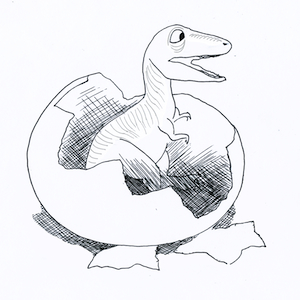
At the Yale Peabody Museum of Natural History, glass cases around an exhibition hall hold fossilized, 75-million-year-old dinosaur eggs. But three eggs, under incubator lamps and the watchful eyes of Peabody staff, are not like the others. While the others lie still, as they have for millions of years, these speckled blue eggs wobble and shake in their enclosure. They contain the stars of this special exhibition, Tiny Titans: Dinosaur Eggs and Babies: three baby emus.
On March 15, as the Peabody shut its doors for the day, the first baby emu poked through its shell. By the time the museum opened the next morning, the three fuzzy-bodied chicks had fully hatched. Crowds gathered, and even more joined in online via livestream as the chicks took their first long-toed steps only a few feet from their unborn Mesozoic ancestors.
A sign at the opening of the exhibit proclaims: Birds are living dinosaurs. With interactive games and painted artwork, the exhibit explains this relationship, highlighting the unexpected evolutionary connections between dinosaurs and birds. The baby emus drive the point home.
Human understanding of the connections between dinosaurs and birds dates back almost a century. Richard Prum, professor of ornithology in the Department of Ecology and Evolutionary Biology at Yale and a head curator at the Peabody, said that researchers have worked to understand the link between dinosaurs and modern birds since the discovery of the first dinosaur egg in the Gobi Desert in 1923. But certain questions about the dinosaurs’ own lives remained: Scientists didn’t quite understand the relationship between dinosaur parents and their children. Conventional wisdom dictated that dinosaurs laid eggs and left their babies to fend for themselves, but a 1958 discovery of a fossilized dinosaur nest in Montana led scientists to the revelation that instead of simply laying eggs and leaving, dinosaurs lavished attention on their offspring. The evidence indicates that dinosaurs actively parented their young—providing nourishment, shelter, and protection against predators—much like birds do today.
The connection between birds and dinosaurs involves not only genetics but also shared behavior. “Birds have obligatory parental care—they don’t just litter eggs and leave them in the sand,” Prum said. “It turns out now we have great fossil evidence that this capacity is actually deeply dinosaurian. At dinosaur nests, there are individuals that have been fossilized in the act of at least protecting if not incubating their eggs, and this implies that aspects of bird biology are actually dinosaur biology.”
Of all birds, emus are among those most closely related to dinosaurs. This closeness manifests itself in behavior as well as appearance. Females lay the eggs, but males watch over them and then care for the young. This behavior was previously believed to be exclusive to emus and other flightless birds such as ostriches and kiwis. But paleontologists have concluded that these birds raise their young in the same way as theropod dinosaurs, such as the T-Rex, did. Because of these similarities, emus really are the most scientifically appropriate way to bring dinosaur behavior to life. “When kids see dinosaur eggs and then see live emus running round, they won’t forget that birds are dinosaurs,” said Richard Kissel, director of public programs.
Space constraints prevented the Peabody from hosting an emu dad to fully demonstrate dinosaur-parenting behavior, so the babies had to put up with a human father. Jim Sirch, the museum’s education coordinator, rotated the eggs in the incubator, as their father would have done. Two weeks after they hatched, the emus returned to their original home in Massachusetts. In about two years, when they have reached sexual maturity, they too will be ready to coddle their chicks, just like their dinosaur ancestors.
But with every bird circling the New Haven sky, we’re reminded that dinosaurs are more than the monsters in the movies—they’re also our familiar neighbors.

